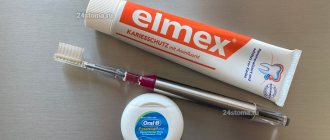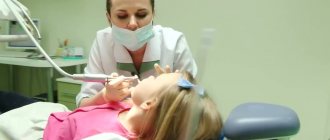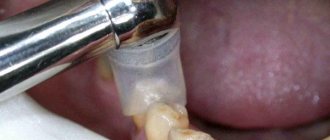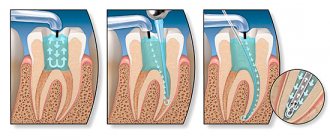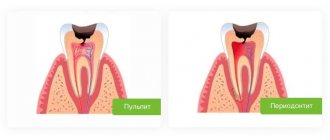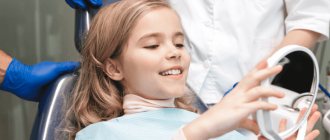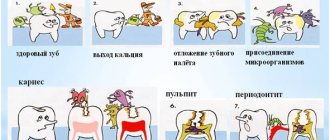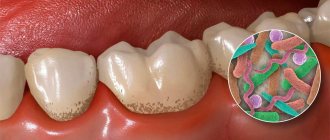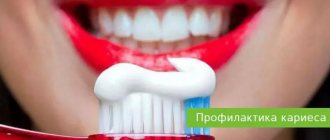In this article
- In what cases does dental caries develop: risk factors
- Prevention of dental caries: primary, secondary and tertiary
- Methods of primary prevention of caries
- The role of nutrition in preventing dental caries
- How to reduce the adverse effects of carbohydrates on teeth
- Strengthening the immune system and reducing stress factors as methods for preventing dental caries
- Drug prophylaxis
- Sealing dental fissures as caries prevention
- Personal oral hygiene as protection against caries
- How to brush your teeth correctly to avoid caries?
- Chewing gums as caries prevention
According to official statistics from the World Health Organization, almost 100% of the world's population has dental caries. Modern dentistry offers effective methods for treating this disease, but prevention plays the most important role in preventing caries.
In what cases does dental caries develop: risk factors
The condition of teeth is one of the main indicators of the overall health of the human body. Therefore, preventive measures aimed at reducing the risk of caries development are an important element of comprehensive health improvement. To protect teeth from carious lesions, it is necessary to understand what contributes to the development of the disease.
There are three main risk factors:
- dental plaque and the microbes it contains;
- increased amount of sugar in food;
- lack of fluoride in food and water.
In addition to these main factors in the development of caries, to varying degrees, the risk of pathology may depend on the level of solar radiation, gender and age, climatic and geographical living conditions. The likelihood of illness increases with pathological pregnancies, systemic and acute infectious diseases, during radiotherapy and other influences that weaken the immune system. An important risk factor is insufficient or improper dental and oral hygiene.
Comprehensive prevention of caries in adults involves influencing the main risk factors using different methods. Thanks to such preventive measures, it is possible to eliminate or reduce the risk of developing dental caries.
How to avoid caries?
Depending on the depth of damage to hard tissues, there are 3 stages of caries - initial (spot stage), medium, deep. The rate of destruction of dental structures varies. In adults, the disease is predominantly sluggish and chronic. Children are more often diagnosed with an acute form of the disease with rapid destruction of dental structures. Inattention to the condition of teeth leads to progression of the disease. A carious lesion from the spot stage very quickly passes into the middle form, when dentin is destroyed and a visually noticeable defect is formed - a carious cavity.
How to avoid caries? Simple methods of primary prevention will help with this, most relevant when there is no visible damage to dental tissues.
Prevention of dental caries: primary, secondary and tertiary
In modern dentistry, there are three important stages of caries prevention. Primary prevention helps prevent the development of dental caries. It involves performing procedures that eliminate the factors and causes that provoke the disease. Secondary allows you to detect the disease at an early stage and take measures that will stop its development and prevent its reappearance. Tertiary is a set of measures after the main treatment. It can be aimed at restoring dentition, chewing function, or the lost appearance of teeth.
How to identify caries?
The simplicity and reliability of determining caries very much depends on the stage of its development, as well as the localization of foci of destruction on the dentition. At home, at the stage of a carious spot, when the pathology is located in the cervical, rib or root zone, it is almost impossible to visually notice the disease. Only a clear outer location on the visible part of the enamel suggests the presence of a small area of chalky color.
During the transition from the basic stage to classic superficial caries, the affected area acquires a more pronounced whitish tint, while the localization loses its shine compared to the rest of the enamel - active demineralization and destruction of the outer layer of the tooth begins, which is still focal. Over time, the diseased tooth begins to react to too cold, hot, sour, sweet foods and drinks, forming a temporary pain syndrome.
In medium and deep forms of the disease, the pathology is visible to the naked eye - these are darkening, holes and black cavities, partial tooth destruction, etc.
A particularly important stage in the effective fight against caries is considered to be the earliest possible diagnosis of the problem - only an experienced dentist can carry it out properly, through both a thorough visual examination using a special mirror and instrumental research techniques. Most often in modern dentistry, the following is used to solve this problem:
- 1. Radiography. A photograph of the internal structure of the dentition and surrounding areas gives, with correct interpretation, a clear and unambiguous picture of the development of caries and the exact localization of lesions;
- 2. Coloring. A simple method performed in a regular dental office. The procedure is carried out using fuchsin or methylene blue - areas of superficial damage to the enamel change their color;
- 3. Transluminescence. Illumination of the inside of the dentition using a powerful light source. Allows you to detect internal and hidden forms of caries inside the tooth;
- 4. Cold thermal diagnostics and drying of the enamel surface. Two alternative methods involve treating potential affected areas with a cold reagent or drying them, respectively. In the first case, the patient will feel a slight pain syndrome, while in the second, the area of potential destruction loses its shine. Both methods are suitable for identifying superficial or medium caries, including in hard-to-reach places.
Methods of primary prevention of caries
They are divided into endogenous (impact on internal factors) and exogenous (impact directly on the tooth surface).
Endogenous prevention measures include:
- complete, balanced, varied diet;
- activities aimed at strengthening the immune system;
- elimination of stress factors;
- taking vitamin and mineral supplements and saturating the body with fluoride, calcium and other microelements necessary for dental health.
Exogenous prevention of caries is:
- brushing your teeth daily using a good toothbrush, toothpaste and floss;
- professional cleaning by a dentist twice a year;
- treatment of tooth enamel with preparations containing fluoride;
- limited consumption of sweets and other foods rich in carbohydrates;
- use of chewing gum;
- sealing fissures (natural pits and grooves) on children's teeth.
Comprehensive caries prevention measures help reduce the likelihood of its occurrence several times.
conclusions
There is a clear algorithm, following which, with a high degree of probability, you will never encounter the problem of caries.
- Regular removal of plaque and tartar is the key to healthy teeth . Good oral hygiene is the best cure for any disease related to teeth and gums.
- Proper diet . It is necessary to compose the daily menu in such a way that it contains as little flour and sweets as possible (food consisting mainly of easily digestible carbohydrates). It is also worth giving up sugary drinks (soda contains an extremely large amount of sugar). By avoiding sugary snacks, you can minimize your risk of tooth decay.
- Measures that increase the resistance of enamel to acids produced by pathogenic microorganisms should be carried out several times a year.
The role of nutrition in preventing dental caries
One of the effective measures to combat caries is the correct approach to nutrition. The tissues of the oral cavity are sensitive to the lack of certain food components. In particular, a lack of protein in the diet prevents the accumulation of calcium and disrupts the structure and strength of enamel. At the same time, foods that are too fatty increase the permeability of the enamel, which increases the likelihood of the formation of carious lesions.
An excess of refined carbohydrates (sweets, flour products, sugar) in the diet not only reduces the resistance of teeth to the development of caries, but also weakens the immune defense, which is also a risk factor.
To prevent caries, it is important to adhere to the following dietary recommendations:
- A sufficient amount of protein must be present in the daily diet;
- eat foods containing vitamins C, D and group B;
- be sure to eat foods rich in calcium and phosphorus (milk, cheese, eggs, fish, broccoli, legumes), as well as fluoride-containing foods (sea fish, Georgian tea);
- it is necessary to limit the consumption of foods rich in “fast” carbohydrates, eat as little sweets, cakes and refined sugar as possible;
- Avoid sticky products: they can remain on the surface of tooth enamel for up to an hour, contributing to its demineralization for a long time.
The nature of your diet directly affects the condition of your teeth. A rational, fortified, balanced diet is an effective method of non-drug prevention of caries.
Treatment methods for caries in the spot stage
The appearance of a matte white smooth spot on the enamel is the first sign of a carious process. Such a stain means that the enamel in this place is demineralized and is more susceptible to destruction. Qualified therapy includes the following:
- professional hygiene;
- remineralization therapy, which uses drugs for the prevention of caries containing fluoride and calcium;
- regular dental examinations.
One of the latest innovations in drill-free treatment is Icon technology. After pre-treatment, a special infiltrate is applied to the affected area of enamel. The material penetrates deeply into the enamel structure, filling the defect. Excess material is removed, and the treated area is polymerized with a UV lamp. The defect is sealed, the carious process stops.
If the stain has reached the stage of pigmentation and a cavity defect has appeared on the enamel, then the affected tooth will require preparation followed by filling. The dentist selects the treatment method according to the clinical picture.
How to reduce the adverse effects of carbohydrates on teeth
Fermentation of carbohydrates under the influence of microbes leads to the production of organic acid, which destroys tooth enamel and contributes to the development of caries. It is impossible to completely stop eating carbohydrates, but it is quite possible to reduce the intensity of their influence on the development of caries. The following measures will help with this:
- Reducing the amount and, most importantly, the frequency of eating carbohydrate foods, so that the teeth come into contact with carbohydrates as little as possible.
- In some cases, your doctor may recommend switching from sugar to sweetener substitutes.
- Reducing the time carbohydrates spend in the mouth. This can be achieved in two ways: do not eat the sweet dish last, and be sure to rinse your mouth after eating.
- Avoid eating sweets at night and between meals.
If any of the recommendations are violated, to reduce the risk of caries, you need to brush your teeth and rinse your mouth.
Stopping the development of caries
It is advisable to stop the development of caries at the earliest possible stage: in this case, the disease will be much easier to treat.
At the initial stage, caries looks like a small spot. At this stage of development, it can be coated with a special gel that can restore damaged enamel. If you see a doctor on time, you may be able to do without the preparation procedure, which is, of course, completely painless.
If you start the development of caries, you will have to resort to drilling, and if the pulp is affected, this can add additional painful sensations.
In addition, ignoring caries is fraught with:
- destruction of the affected tooth and, as a result, expensive installation of an implant;
- indigestion, since the affected teeth cannot fully cope with the chewing function;
- aesthetic inconveniences.
Strengthening the immune system and reducing stress factors as methods for preventing dental caries
The most important task of the immune system is to resist the effects of microbes. If the body's defenses are weakened (including under the influence of stress), the immune system cannot resist harmful bacteria. That is why, against the background of severe stress and weakened immunity, the risk of dental caries increases.
Prevention consists of strengthening the immune system, for which the following measures are suitable:
- quality sleep of at least 8 hours;
- physical activity: daily exercise, sports;
- hardening: water procedures, sun and air baths, cool air in the apartment;
- avoidance of stressful situations;
- refusal or limitation of bad habits (smoking, alcohol);
- adherence to daily routine;
- if necessary and only as prescribed by a doctor, medications to strengthen the immune system.
Is professional teeth cleaning necessary?
Some dentists recommend polishing and grinding your teeth, or professional cleaning, twice a year. However, this procedure has a number of contraindications: allergic reactions to the medications used, enamel sensitivity, bleeding gums.
In 2005, eight studies[] were conducted on the effects of professional dental cleanings on dental health. None of them even confirmed the safety of this procedure, let alone the need to do it regularly.
Drug prophylaxis
After an in-person examination, the dentist, according to indications, may prescribe the patient one of the following methods of medicinal endogenous prophylaxis:
- additional fluoridation of food and drinking water (the amount of fluoride is calculated only by a doctor, taking into account the dose that a person already receives from food and water);
- anti-caries drugs for oral administration (usually they contain a complex of vitamins and sodium fluoride that help strengthen teeth).
There are also exogenous methods of drug prophylaxis. These include coating the teeth with fluoride varnish or fluoride gel. Fluoride varnish stays on the enamel surface for a long time, saturates it with fluoride ions, has an antimicrobial effect, and reduces pain in cases of increased tooth sensitivity. Fluoride-containing gel has a remineralizing effect on tooth enamel; it is used for applications or electrophoresis.
Which toothpaste is more effective?
The good news is that brushing your teeth is still beneficial. But to prevent the development of caries, the paste must contain fluoride. A study of the results of dental examinations of children aged 5 to 16 years []confirmed the effectiveness of the use of this mineral for the prevention of caries and tooth loss. Moreover, it is better to brush your teeth with fluoride paste twice, not once: the positive effect will be more noticeable.
True, fluoride paste does not help against gingivitis and plaque on teeth. But it really protects against enamel destruction.
Sealing dental fissures as caries prevention
Fissures are natural depressions on the surface of teeth. Food debris accumulates in these pits, making it more difficult to remove plaque and germs from there during cleaning. In addition, in the fissure area, enamel mineralization is slowed down; its layer is thinner than on other surfaces of the teeth, so natural depressions are considered a risk zone for the development of carious lesions. The fissure sealing method is primarily used for children. Its essence lies in the fact that the recesses are closed with special sealants. As a result, food does not accumulate on the teeth, and the vulnerable spot of the tooth surface is reliably protected from the action of pathological microorganisms.
Causes of dental disease
There are many reasons why tooth enamel is destroyed. The main thing is damage by microorganisms that develop in the human mouth. As a result of their activity, bacteria produce organic acids that dissolve hard tissues. Therefore, the main measure to prevent dental caries is careful oral hygiene.
Factors that cause the development of the disease also include the following:
- Excessive viscosity of saliva. If saliva is viscous, plaque from the tooth surface, where bacteria develop, is not naturally removed. Therefore, it must be removed during professional cleaning by the dentist.
- Crowded bite, in which it is important to thoroughly clean the space between the teeth.
- Poor or complete lack of oral hygiene.
- Stone formation, which also causes periodontal problems.
- Eating foods high in carbohydrates. Therefore, it is better to consume sweets in moderation.
- Exposure to harmful occupational factors. Carious lesions often develop in people working in hazardous industries.
- Injuries to the coronal part that cause the destruction process. The enamel is damaged, so it is more susceptible to negative effects.
Dental disease can be caused by a hereditary predisposition.
Most often, carious cavities develop on contact surfaces, in the blind pits of the incisors, in the cervical region, and on fissures. To prevent the development of the disease, various methods of caries prevention are used.
Personal oral hygiene as protection against caries
Individual oral hygiene plays an important role in preventing caries. It refers to exogenous non-drug methods of prevention.
Regular brushing of teeth, tongue, removal of food debris, soft deposits contributes to the proper development and functioning of tooth enamel. The components of therapeutic and prophylactic pastes enrich the tissues of the oral cavity with calcium and phosphate salts, vitamins and microelements, making them more resistant to negative influences. Massaging the gums with a toothbrush activates metabolism, improves blood circulation in periodontal tissues, and prevents bleeding and gum disease.
Personal hygiene involves careful independent removal of plaque from the surface of teeth and gums using toothbrushes, pastes and other products.
The effectiveness of individual oral hygiene depends on several factors:
- quality and compliance of the characteristics of the toothbrush with the condition of the teeth of a particular patient;
- following proper cleaning techniques;
- the use of additional cleansing methods - irrigators, dental floss, mono-beam and orthodontic brushes, rinses.
ANTENATAL PREVENTION
It is mistakenly believed that children need to take care of their oral cavity from about the age of three. In fact, the prerequisites for the occurrence of dental diseases often arise even before the baby is born. The rudiments of baby teeth begin to form already from the sixth week of pregnancy, and the rudiments of permanent teeth - from the twentieth. If during this period the fetus does not receive calcium and other microelements, the mineralization of dental tissues slows down, and the baby may subsequently have serious problems not only with milk teeth, but also with permanent teeth.
The goal of antenatal prevention is to prevent the child from developing dental diseases associated with problems in the prenatal period. To provide the fetus with the microelements it needs, a special nutritional plan is developed for the expectant mother.
In addition, if a woman suffers from periodontal disease during pregnancy, the newborn baby is at risk. In contact with the mother, the child will certainly become infected with pathogenic bacteria, and the erupted milk teeth will be affected by caries. Therefore, all actions to sanitize the oral cavity of the expectant mother should be carried out even before birth. The use of painkillers is possible from approximately 16 weeks of pregnancy.
WHY IS IT IMPORTANT TO VISIT A DENTIST REGULARLY?
In order to prevent the occurrence of caries, hygiene procedures alone are not always enough. If a patient has an incorrect bite or the teeth are too close together, orthodontic treatment may be necessary.
According to the accepted classification, according to the depth of damage, caries is divided into initial, superficial, medium and deep. This is an insidious disease, and it is quite difficult to independently determine it at the initial stage. The first carious spots almost do not differ in color from tooth enamel, and if you do not pay attention to them, the disease can very quickly go through all stages, completely destroy the tooth and affect neighboring ones.
Early diagnosis of caries allows for its treatment using the most gentle methods. It is very important to prevent the development of the disease and the occurrence of complications, in particular, periodontal inflammation, when no home remedies or rinses can help. Therefore, it is necessary to visit the dentist at least once every six months for a preventive examination and exogenous procedures.
The DentaLux-M dental clinic has developed an effective system for the prevention of dental diseases. Experienced doctors use the most modern equipment and new technologies.
By visiting the clinic once every six months and following your dentist’s recommendations, you will maintain a radiant smile for a long time.
How to brush your teeth correctly to avoid caries?
The toothbrush should have a small head to easily penetrate hard-to-reach areas of the oral cavity, removing plaque even from distant teeth and from interdental spaces. The stiffness of the bristles is of great importance. The best choice for most adult users is a medium-hard brush. It will clean the surface of the teeth quite intensively, without damaging the gums or scratching the enamel.
However, for children and those with sensitive teeth and gums, brushes with soft bristles are needed. Regarding the correct choice of the optimal toothbrush, as well as toothpaste with the appropriate composition, it is better to consult with your dentist. He will be able to make recommendations based on an in-person examination of the oral cavity.
Even a properly selected brush and good toothpaste will not protect against caries if you brush your teeth incorrectly. Therefore, it is important to learn a technique that will allow you to most effectively clean your teeth and oral cavity from bacteria. There are several different ways to clean teeth in dentistry. One of the widely used is the standard Pakhomov method:
- The dentition is conventionally divided into segments.
- Begin cleaning from the upper right segment, from the distant chewing teeth. They alternately move from segment to segment along the upper jaw, and then move on to cleaning the lower row of teeth in a similar way.
- According to Pakhomov’s method, when cleaning the lateral front and back surfaces of the teeth, the brush moves in the direction from the gums to the edge of the tooth. Chewing surfaces are cleaned with back-and-forth movements.
- Finish cleaning with circular movements in each segment.
Please note that this cleaning method is suitable for those who use regular manual toothbrushes. There are nuances in using electric toothbrushes, and the method of using them is always detailed in the instructions. The main difference is that an electric toothbrush does not require mechanical movements; it simply needs to be moved from tooth to tooth without applying too much pressure.
After brushing your teeth with a brush and toothpaste, it is recommended to additionally clean the interdental spaces with floss or irrigator, and also use the mouthwash as a solution for the prevention of caries.
Prevention of caries development in children and adults
According to official statistics from the World Health Organization, almost 100% of the world's population has dental caries. Modern dentistry offers effective methods for treating this disease, but prevention plays the most important role in preventing caries.
In what cases does dental caries develop: risk factors
The condition of teeth is one of the main indicators of the overall health of the human body. Therefore, preventive measures aimed at reducing the risk of caries development are an important element of comprehensive health improvement. To protect teeth from carious lesions, it is necessary to understand what contributes to the development of the disease.
There are three main risk factors: dental plaque and the microbes it contains; increased amount of sugar in food; lack of fluoride in food and water. In addition to these main factors in the development of caries, to varying degrees, the risk of pathology may depend on the level of solar radiation, gender and age, climatic and geographical living conditions. The likelihood of illness increases with pathological pregnancies, systemic and acute infectious diseases, during radiotherapy and other influences that weaken the immune system. An important risk factor is insufficient or improper dental and oral hygiene.
Comprehensive prevention of caries in adults involves influencing the main risk factors using different methods. Thanks to such preventive measures, it is possible to eliminate or reduce the risk of developing dental caries.
Prevention of dental caries: primary, secondary and tertiary
In modern dentistry, there are three important stages of caries prevention. Primary prevention helps prevent the development of dental caries. It involves performing procedures that eliminate the factors and causes that provoke the disease. Secondary allows you to detect the disease at an early stage and take measures that will stop its development and prevent its reappearance. Tertiary is a set of measures after the main treatment. It can be aimed at restoring dentition, chewing function, or the lost appearance of teeth.
Methods of primary prevention of caries
They are divided into endogenous (impact on internal factors) and exogenous (impact directly on the tooth surface). Endogenous preventive measures include: a complete, balanced, varied diet; activities aimed at strengthening the immune system; elimination of stress factors; taking vitamin and mineral supplements and saturating the body with fluoride, calcium and other microelements necessary for dental health. Exogenous prevention of caries is: daily brushing of teeth using a good toothbrush, paste and floss; professional cleaning by a dentist twice a year; treatment of tooth enamel with preparations containing fluoride; limited consumption of sweets and other foods rich in carbohydrates; use of chewing gum; sealing fissures (natural pits and grooves) on children's teeth. Comprehensive caries prevention measures help reduce the likelihood of its occurrence several times.
The role of nutrition in preventing dental caries
One of the effective measures to combat caries is the correct approach to nutrition. The tissues of the oral cavity are sensitive to the lack of certain food components. In particular, a lack of protein in the diet prevents the accumulation of calcium and disrupts the structure and strength of enamel. At the same time, foods that are too fatty increase the permeability of the enamel, which increases the likelihood of the formation of carious lesions.
An excess of refined carbohydrates (sweets, flour products, sugar) in the diet not only reduces the resistance of teeth to the development of caries, but also weakens the immune defense, which is also a risk factor. To prevent caries, it is important to adhere to the following nutritional recommendations: a sufficient amount of protein must be present in the daily diet; eat foods containing vitamins C, D and group B; be sure to eat foods rich in calcium and phosphorus (milk, cheese, eggs, fish, broccoli, legumes), as well as fluoride-containing foods (sea fish, Georgian tea); it is necessary to limit the consumption of foods rich in “fast” carbohydrates, eat as little sweets, cakes and refined sugar as possible; Avoid sticky products: they can remain on the surface of tooth enamel for up to an hour, contributing to its demineralization for a long time.
The nature of your diet directly affects the condition of your teeth. A rational, fortified, balanced diet is an effective method of non-drug prevention of caries.
How to reduce the adverse effects of carbohydrates on teeth
Fermentation of carbohydrates under the influence of microbes leads to the production of organic acid, which destroys tooth enamel and contributes to the development of caries. It is impossible to completely stop eating carbohydrates, but it is quite possible to reduce the intensity of their influence on the development of caries. The following measures will help with this: Reducing the amount and, most importantly, the frequency of eating carbohydrate foods, so that the teeth come into contact with carbohydrates as little as possible. In some cases, your doctor may recommend switching from sugar to sweetener substitutes. Reducing the time carbohydrates spend in the mouth. This can be achieved in two ways: do not eat the sweet dish last, and be sure to rinse your mouth after eating. Avoid eating sweets at night and between meals.
If any of the recommendations are violated, to reduce the risk of caries, you need to brush your teeth and rinse your mouth.
Strengthening the immune system and reducing stress factors as methods for preventing dental caries
The most important task of the immune system is to resist the effects of microbes. If the body's defenses are weakened (including under the influence of stress), the immune system cannot resist harmful bacteria. That is why, against the background of severe stress and weakened immunity, the risk of dental caries increases.
Prevention consists of strengthening the immune system, for which the following measures are suitable: quality sleep for at least 8 hours; physical activity: daily exercise, sports; hardening: water treatments, sun and air baths, cool air in the apartment; avoidance of stressful situations; refusal or limitation of bad habits (smoking, alcohol); adherence to daily routine; if necessary and only as prescribed by a doctor, medications to strengthen the immune system.
Drug prophylaxis
After an in-person examination, the dentist, according to indications, can prescribe to the patient one of the following methods of medicinal endogenous prevention: additional fluoridation of food and drinking water (the amount of fluoride is calculated only by the doctor, taking into account the dose that the person already receives from food and water); anti-caries drugs for oral administration (usually they contain a complex of vitamins and sodium fluoride that help strengthen teeth).
There are also exogenous methods of drug prophylaxis. These include coating the teeth with fluoride varnish or fluoride gel. Fluoride varnish stays on the enamel surface for a long time, saturates it with fluoride ions, has an antimicrobial effect, and reduces pain in cases of increased tooth sensitivity. Fluoride-containing gel has a remineralizing effect on tooth enamel; it is used for applications or electrophoresis.
Sealing dental fissures as caries prevention
Fissures are natural depressions on the surface of teeth. Food debris accumulates in these pits, making it more difficult to remove plaque and germs from there during cleaning. In addition, in the fissure area, enamel mineralization is slowed down; its layer is thinner than on other surfaces of the teeth, so natural depressions are considered a risk zone for the development of carious lesions. The fissure sealing method is primarily used for children. Its essence lies in the fact that the recesses are closed with special sealants. As a result, food does not accumulate on the teeth, and the vulnerable spot of the tooth surface is reliably protected from the action of pathological microorganisms.
Personal oral hygiene as protection against caries
Individual oral hygiene plays an important role in preventing caries. It refers to exogenous non-drug methods of prevention.
Regular brushing of teeth, tongue, removal of food debris, soft deposits contributes to the proper development and functioning of tooth enamel. The components of therapeutic and prophylactic pastes enrich the tissues of the oral cavity with calcium and phosphate salts, vitamins and microelements, making them more resistant to negative influences. Massaging the gums with a toothbrush activates metabolism, improves blood circulation in periodontal tissues, and prevents bleeding and gum disease. Personal hygiene involves careful independent removal of plaque from the surface of teeth and gums using toothbrushes, pastes and other products. The effectiveness of individual oral hygiene depends on several factors: the quality and compliance of the characteristics of the toothbrush with the condition of the teeth of a particular patient; following proper cleaning techniques; the use of additional cleansing methods - irrigators, dental floss, mono-beam and orthodontic brushes, rinses.
How to brush your teeth correctly to avoid caries?
The toothbrush should have a small head to easily penetrate hard-to-reach areas of the oral cavity, removing plaque even from distant teeth and from interdental spaces. The stiffness of the bristles is of great importance. The best choice for most adult users is a medium-hard brush. It will clean the surface of the teeth quite intensively, without damaging the gums or scratching the enamel.
However, for children and those with sensitive teeth and gums, brushes with soft bristles are needed. Regarding the correct choice of the optimal toothbrush, as well as toothpaste with the appropriate composition, it is better to consult with your dentist. He will be able to make recommendations based on an in-person examination of the oral cavity.
Even a properly selected brush and good toothpaste will not protect against caries if you brush your teeth incorrectly. Therefore, it is important to learn a technique that will allow you to most effectively clean your teeth and oral cavity from bacteria. There are several different ways to clean teeth in dentistry. One of the most widespread is the standard Pakhomov method: The dentition is conventionally divided into segments. Begin cleaning from the upper right segment, from the distant chewing teeth. They alternately move from segment to segment along the upper jaw, and then move on to cleaning the lower row of teeth in a similar way. According to Pakhomov’s method, when cleaning the lateral front and back surfaces of the teeth, the brush moves in the direction from the gums to the edge of the tooth. Chewing surfaces are cleaned with back-and-forth movements. Finish cleaning with circular movements in each segment.
Please note that this cleaning method is suitable for those who use regular manual toothbrushes. There are nuances in using electric toothbrushes, and the method of using them is always detailed in the instructions. The main difference is that an electric toothbrush does not require mechanical movements; it simply needs to be moved from tooth to tooth without applying too much pressure.
After brushing your teeth with a brush and toothpaste, it is recommended to additionally clean the interdental spaces with floss or irrigator, and also use the mouthwash as a solution for the prevention of caries.
Chewing gums as caries prevention
Chewing gum may help prevent tooth decay by increasing saliva production. Salivary fluid washes each tooth, removing dirt and germs from it, has an antiseptic effect on the oral cavity, and neutralizes plaque acids. For preventive purposes, it is recommended to chew gum with sweeteners for several minutes after each meal, especially sweets. Remember that comprehensive preventive measures will help maintain the health and appearance of your teeth for a long time. Sources: e-stomatology.ru, novstom21.med.cap.ru, sp1-tmn.ru, dentart.org rzgmu.ru, ochkov.net
Chewing gums as caries prevention
Chewing gum may help prevent tooth decay by increasing saliva production. Salivary fluid washes each tooth, removing dirt and germs from it, has an antiseptic effect on the oral cavity, and neutralizes plaque acids. For preventive purposes, it is recommended to chew gum with sweeteners for several minutes after each meal, especially sweets. Remember that comprehensive preventive measures will help maintain the health and appearance of your teeth for a long time.
Do I need a dental scan?
American dentists recommend having your teeth x-rayed every year. Austin Frakt, a health economist, reviewed[] medical studies and concluded that such reinsurance is unwarranted. Cavities in the tooth form more slowly—over 2–3 years.
In Russia, preventive x-rays are not so popular. But computed tomography is suggested to be done regularly. You should also not agree to this expensive service more often than once every couple of years.
How and why does caries develop?
Normally, saliva destroys all harmful microorganisms in the oral cavity. This protective mechanism is provided by nature. But when a malfunction occurs in the body or negative factors actively influence it, saliva loses its protective properties. And if a large number of cariogenic microbes accumulate in the oral cavity, many organic acids are formed (lactic, butyric, formic, propionic, etc.). It is these substances that soften enamel and dentin and destroy the tooth structure. Thus, the more of these bacteria, the more acid, the faster the unit breaks down.
Caries forms on teeth if a person:
- consumes a lot of foods containing simple carbohydrates (sweets, baked goods) - such food promotes the proliferation of cariogenic bacteria;
- does not care about enriching the enamel with calcium and fluoride;
- likes to create a temperature contrast (eats cold food immediately after hot food), which negatively affects the condition of the enamel;
- rarely or poorly brushes teeth;
- neglects preventive visits to the dentist and recommendations regarding professional cleaning of units.
This problem often occurs in people with reduced immunity (due to systemic disease, frequent fatigue, chronic stress), as well as in pregnant and lactating women (due to increased consumption of calcium and fluoride).
Is it easy to detect tooth damage?
When caries first appears, it appears as a white or brown spot. Due to the small size of the defect, the patient will most likely not notice the problem. Only people with increased sensitivity of the enamel may experience pain, which will prompt the idea of contacting a specialist.
As the pathology progresses, the patient will experience the following symptoms:
- pain in response to irritants (sour, sweet, cold, hot foods) or chewing hard foods;
- the appearance of brown or black areas on the tooth;
- coating on the tongue;
- the formation of a cavity that can be palpated with the tongue and can scratch and injure its mucous membrane;
- bad breath that does not disappear after proper cleaning and use of mouthwash.
If these signs of illness appear, you need to visit the dentist in the coming days and undergo the recommended treatment. No folk remedies will help eliminate caries! Even if the tooth begins to hurt less or the pain subsides altogether, a consultation with a dentist is necessary. Otherwise, the development of complications cannot be avoided.
Proper dental care -
Unfortunately, all people understand the term “good oral hygiene” differently, believing that everything is fine with their hygiene, and that all dental problems are to blame (hereinafter on the list) - water, bad heredity, pregnancy, etc. . Below we have described in detail for you how often and how to brush your teeth correctly, as well as what hygiene products are best to use.
How many times a day should you brush your teeth?
Most people know that they need to brush their teeth twice a day. Everything is correct, but this is only the minimum value. Normally, teeth are brushed after every meal, i.e. 3 times a day. If you are afraid that your colleagues at work will call you a cleaner if they see you brushing your teeth in the toilet during your lunch break, then you need to make a choice - between clean teeth, the absence of caries and bad breath, and the respect of dirty-toothed colleagues.
If a toothbrush and paste at work are unacceptable to you, then the minimum amount of hygiene that will allow you to remain Homo sapiens is dental floss + chewing gum. The most important thing in this combination is the use of dental floss, because... food gets stuck between the teeth (and we are not talking about stuck pieces of meat, but about soft food residues, which cause much more damage to the teeth, because they consist of quickly digestible carbohydrates and therefore are most quickly processed by bacteria into acid).
Diet – effective prevention of dental caries is impossible without following a diet. For example, it is very good if you brush your teeth 3 times a day after each main meal. But, if you decide to eat chocolate, cookies, sweets, nuts between main meals... the carbohydrates stick to your teeth again and bacteria immediately begin to convert them into acid. Therefore, all snacks should be eaten at the end of the main meal, and after that, immediately brush your teeth.
It is the wrong diet and frequent snacking on cookies and other carbohydrates that are the root cause of caries in children (this also applies to sugary drinks - juices, soda, liquid mixtures). Children often develop so-called bottle caries, which affects almost all teeth (when parents, to prevent the child from crying, give him a bottle of formula for the whole night or day). And without solving the problem with diet, no prevention of caries in children is simply possible.
If you are asking yourself how to get rid of caries at home, then following the recommendations of this article can almost completely save you from the appearance of new foci of caries. It's up to your willpower and motivation, because sometimes you are too lazy to get up and go straight away to brush your teeth, or finally start regularly using dental floss after every meal.
Proper hygiene scheme -
After each meal, you need to follow the following sequence: 1) flossing, 2) brushing with a toothbrush and toothpaste. If you don’t have toothpaste and a brush, you should always have dental floss and chewing gum with you. Floss will remove food debris, and chewing gum works by stimulating salivation (saliva has a certain buffering capacity that neutralizes acids in the mouth).
It is very important not only how to brush your teeth, but also when to do it. In the morning, it is best to brush your teeth after breakfast (for people with a lot of plaque and carious teeth, this can be unpleasant, so it is recommended for such patients to brush their teeth both before and after breakfast). As for all other oral hygiene sessions, teeth should be brushed within the first 5 minutes after eating.
Using dental floss –
Let's be honest - without dental floss there can be no talk of good hygiene. What do you think: why is the most common location of caries in the interdental spaces? Precisely because food debris gets stuck there, which cannot be removed by any fancy toothbrush models or even irrigators. If the instructions for a brush or an advertisement tell you that it perfectly cleans the spaces between teeth, this is all untrue and is only a publicity stunt. And this equally applies to electric, ultrasonic, and other models of brushes and attachments for them.
It is very important that you understand the following - you should use dental floss not only when you feel that a piece of meat is stuck in your teeth. After eating, so much soft sticky food debris accumulates in the interdental spaces that will not cause you any concern, but it is they (and not pieces of meat) that are the root cause of caries, because... Such food residues consist predominantly of carbohydrates that are easily digestible by bacteria.
Dental floss should be used after every meal, cleaning absolutely all dental spaces. This usually takes about 1 minute, but at the beginning (while you learn to use it) it may take longer. The thread should always be in your pocket or purse. You can use it at a party, in the restroom of a restaurant, or even just on the street. Everything will depend only on your desire to have clean teeth and a pleasant breath.
How to use dental floss correctly: video
→ Types of dental floss, and which one is better
If there are bridges on the teeth, braces -
In the presence of braces and bridges in the oral cavity, conditions are created for the retention of food debris. In the presence of bridges, food is stuffed, as a rule, under the intermediate part of the bridge, which imitates the missing tooth. Therefore, for good hygiene, an ordinary toothbrush and paste, as well as dental floss, will no longer be enough in this case (24stoma.ru).
Special devices called irrigators are designed for these purposes. Such devices deliver under pressure a thin pulsating stream of water, saturated with air microbubbles, with the help of which food debris and microbial plaque are washed away (Fig. 6). Irrigators are also indicated for patients with chronic gum inflammation, because... They also allow you to wash periodontal pockets using special nozzles.
Important: any caries you develop, even a single one, is an indicator that there are defects in your hygiene. You must understand that there is no norm for the formation of a certain number of caries lesions per year. Normally, there should be no caries at all, and if it appears, then this is a question of how correctly you brush your teeth, how regularly, whether you are familiar with dental floss, and also how correct your diet is.
When caries develops, microbial plaque and food debris remain at the edge of the corner. Adequate oral hygiene allows complete removal of both. Predisposing factors, of course, also exist. For example, a low concentration of lysozyme in saliva (this is an enzyme that inhibits the growth of plaque) is of a genetic nature, but this factor is only secondary for the development of caries.
Or the buffering capacity of saliva is too low, which does not effectively neutralize acid in the mouth. This usually occurs in patients who consume too many carbohydrates. In patients with a balanced and protein diet, the buffer capacity of saliva is always normal. Those. here again questions about your diet. Often drinking wine or fruit juices (acid), sweet soda (carbohydrates) - all this also leads to demineralization of teeth and increases the risk of caries.
Clinical researches
ASEPTA toothpastes are clinically proven effective. For example, clinical studies have proven that regular use of professional toothpaste ASEPTA REMINERALIZATION improved the condition of the enamel by 64% and reduced tooth sensitivity by 66% after just 4 weeks.
In addition, clinical studies have proven that regular use of preventive toothpaste ASEPTA ACTIVE for a month can reduce bleeding gums by 60%, improve the overall condition of the oral cavity by 44% and reduce inflammation by 33%.
Sources:
- Report on determining/confirming the preventive properties of toothpaste “ASEPTA PLUS” GENTLE WHITENING” Author: doctor-researcher A.A. Leontyev, head Department of Preventive Dentistry, Doctor of Medical Sciences, Professor S.B. Ulitovsky First St. Petersburg State Medical University named after. acad. I.P. Pavlova, Department of Preventive Dentistry
- Clinical and laboratory assessment of the influence of domestic therapeutic and prophylactic toothpaste based on plant extracts on the condition of the oral cavity in patients with simple marginal gingivitis. Doctor of Medical Sciences, Professor Elovikova T.M.1, Candidate of Chemical Sciences, Associate Professor Ermishina E.Yu. 2, Doctor of Technical Sciences Associate Professor Belokonova N.A. 2 Department of Therapeutic Dentistry USMU1, Department of General Chemistry USMU2
- Report on the determination/confirmation of the preventive properties of personal oral hygiene products “ASEPTA PLUS” Remineralization doctor-researcher A.A. Leontyev, head Department of Preventive Dentistry, Doctor of Medical Sciences, Professor S.B. Ulitovsky First St. Petersburg State Medical University named after. acad. I.P. Pavlova, Department of Preventive Dentistry
- Clinical studies of antisensitive toothpaste “Asepta Sensitive” (A.A. Leontyev, O.V. Kalinina, S.B. Ulitovsky) A.A. LEONTIEV, dentist O.V. KALININA, dentist S.B. ULITOVSKY, Doctor of Medical Sciences, Prof. Department of Therapeutic Dentistry, St. Petersburg State Medical University named after. acad. I.P. Pavlova
- The role of anti-inflammatory rinse in the treatment of periodontal diseases (L.Yu. Orekhova, A.A. Leontyev, S.B. Ulitovsky) L.Yu. OREKHOVA, Doctor of Medical Sciences, Prof., Head of Department; A.A. LEONTIEV, dentist; S.B. ULITOVSKY, Doctor of Medical Sciences, Prof. Department of Therapeutic Dentistry of St. Petersburg State Medical University named after. acad. I. P. Pavlova
- Report on determining/confirming the preventive properties of toothpaste “ASEPTA PLUS” COFFEE and TOBACCO Author: doctor-researcher A.A. Leontyev, head Department of Preventive Dentistry, Doctor of Medical Sciences, Professor S.B. Ulitovsky. First St. Petersburg State Medical University named after. acad. I.P. Pavlova, Department of Preventive Dentistry
- Report on determining/confirming the preventive properties of commercially produced personal oral hygiene products: Asepta toothpaste used in combination with Asepta mouthwash and Asepta gum balm Head. Department of PFS Doctor of Medical Sciences Professor S.B. Ulitovsky St. Petersburg State Medical University named after Academician I.P. Pavlova. Faculty of Dentistry. Department of Preventive Dentistry.
Why do you need interdental brushes?
In 2015, a review of seven studies was published in which 354 patients brushed their teeth in three ways:
- only with a brush;
- brush and floss;
- brush and brushes.
Only once did scientists note that additional cleaning with a brush had advantages over brushing. But the evidence cannot be considered rigorous, since we are talking about a superficial study: the effect has not been analyzed in the long term. The same goes for comparing brushes and dental floss.
There is not enough data yet to draw conclusions about the benefits of brushes for interdental spaces.
Oral hygiene
Regular hygiene procedures are one of the simplest and at the same time effective methods of preventing dental caries. After each meal, doctors strongly recommend rinsing your mouth, and best of all, brushing your teeth. This must be done within the first five minutes after eating, because it is at this time that they are most intensely affected by aggressive factors.
Hygiene procedures must necessarily include the use of dental floss or toothpicks. The floss allows you to effectively clean the interdental space from food debris, which serves as a breeding ground for pathogenic microflora. In most cases, removing such residues with an ordinary brush is not possible, so the use of thread or floss is absolutely necessary. As an additional remedy, you can use rinses - they have anti-inflammatory and antiseptic effects, help maintain a normal acid-base balance in the mouth and freshen breath.
The choice of hygiene products is also extremely important. An extremely effective remedy is the regular use of toothpastes containing fluoride. Fluoride exposure not only helps strengthen tooth enamel, but also has an inhibitory effect on pathogens and helps remove soft plaque. By integrating into the structure of the enamel, fluoride retains calcium in it and increases the resistance of teeth to various destructive factors.
However, fluoride-containing pastes can only be used in those regions where it is contained in water in an amount of no more than 1.2 mg per 1 liter. Otherwise, fluorosis may develop, a disease that occurs due to an excess of fluoride. If it is impossible to use fluoride prophylaxis, it is necessary to give preference to fluoride-free anti-caries pastes containing antibacterial components and a large amount of calcium.
Primary prevention of tooth decay may also include having your teeth professionally cleaned. In a dental office, a doctor can remove even the most persistent deposits, which are one of the important factors in the mechanism of caries formation. For this purpose, a wide range of means is used - from special medications to high-tech ultrasound equipment.
